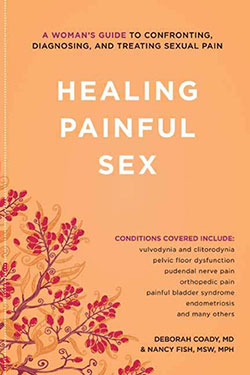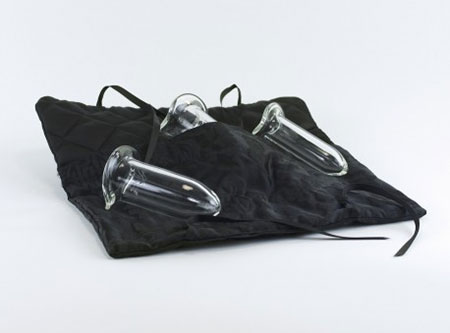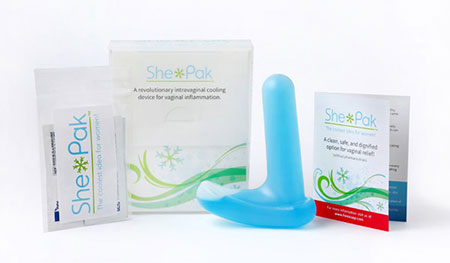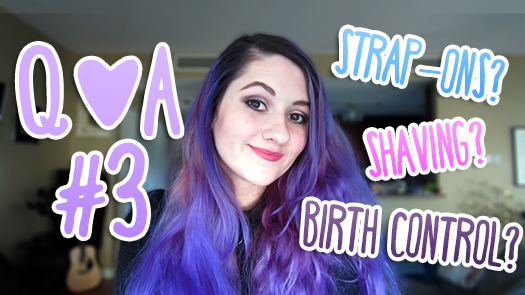Let’s talk about vaginal/pelvic pain conditions and treatment.
Recommendations:
Healing Painful Sex by Deborah Coady and Nancy Fish
Crystal Delights Pacik Glass Dilators
She*Pak Vaginal Cooling Device

When I talk about avoiding pain during penetrative sex, I tend to give a lot of the same advice. Go slowly. Use lube. Make sure you’re completely comfortable and aroused. Try being on top so that you can control the speed and depth of penetration. But I also want to acknowledge that that advice does not work for everyone.
Unfortunately for some people, they could be doing everything “right,” but no amount of lube or position changes is going to make sex not painful for them. In those situations there’s often medical issues at play, so today I want to talk about some of the most common ones.
Vulvodynia is the term for a whole host of conditions that fall under the umbrella of chronic pain of the vulva. The most common subset of vulvodynia is vulvar vestibulitis (also known as vestibulodynia). This involves a localized burning, sharp, or stinging pain at and around the entrance to the vagina. In many cases it is a provoked pain from attempted penetration or any sort of pressure to the area, but it can also just be a constant, generalized pain with no obvious provocation.
Vulvodynia is often treated with antidepressant and anticonvulsant medications as well as topical anesthetics and/or estrogen creams. As a last resort, surgery may be used to alleviate vestibular pain by removing nerve endings at the vaginal entrance.
Pelvic Floor Tension Myalgia is also commonly known as vaginismus. This condition involves involuntary pelvic muscle contraction in response to imminent penetration. Whether it’s a tampon in the bathroom, a speculum in the doctor’s office, or a sex toy or body part in the bedroom, the vagina can reflexively tighten to a point where penetration is difficult and painful.
There are several factors that can contribute to pelvic floor tension myalgia, including previous trauma, mental illness, and physical issues. Treatment typically involves physical therapy for the pelvic floor, often involving Kegel exercises and a dilator set like this one. In the most severe cases, Botox injections are sometimes administered to relax the pelvic muscles.
Pelvic Inflammatory Disease is an infection of the upper reproductive tract that’s often caused by untreated STIs, particularly gonorrhea and chlamydia. Symptoms can include lower abdominal pain, fever, abnormal discharge, longer or worsened periods, bleeding between periods, and, of course, pain during sex. If diagnosed early, pelvic inflammatory disease can be treated and cured with antibiotics.
Pelvic Congestion Syndrome is a condition caused by varicose veins forming within the pelvis. This can cause a chronic, dull ache in the pelvis that is exacerbated by long periods of standing and often gets worse during penetrative sex. Pelvic congestion syndrome can be treated hormonally or by embolizing the varicose veins. As a last resort, a hysterectomy may be required.
Interstitial Cystitis is often referred to as “painful bladder syndrome.” This is a chronic condition characterized by bladder pressure and pain. It acts a bit like an intense, never ending urinary tract infection, with frequent, low volume urination accompanied by a burning sensation in the urethra. It can also cause dyspareunia — painful intercourse.
Treatment for interstitial cystitis may involve antihistamines and antidepressants. A drug called Elmiron, which coats and protects the inside of the bladder, is FDA approved for this condition specifically.
Endometriosis is a condition where endometrial cells from the uterus go, “Fuck this shit, I’m out,” and start growing in other parts of the body, usually still within the pelvic region. That tissue then proceeds with the regular menstrual cycle of thickening, breaking down, and bleeding — but since it’s not in the uterus where it’s supposed to be, it doesn’t have any way to leave the body. This can cause a whole mess of irritation, growths, and lesions in the body and makes itself known through severe cramping, chronic pelvic pain, and sometimes pain during sex.
Endometriosis is often treated with anti-inflammatory medications and hormonal birth control to lessen or prevent menstruation and allow the endometrial tissue to shrink. Beyond that, surgery is sometimes done to remove as much of the tissue as possible, and in the most severe cases a hysterectomy may be necessary.
If you’re someone suffering with chronic pelvic pain, I have a few different recommendations for you. One is the book Healing Painful Sex by Deborah Coady and Nancy Fish. I haven’t personally read it, but it’s been highly recommended by sex educators that I trust.

Another is this glass dilator set from Crystal Delights. Dilators are a wonderful tool for dealing with pelvic floor muscle related issues, and while silicone is the standard, glass dilators are another really great option. They provide less friction going in and out of the vagina, and they can also be chilled or heated in different temperatures of water to soothe inflammation in different ways.

On the temperature subject there is also this product called the She*Pak which is basically an ice pack for your vagina and it’s great for soothing irritation from the inside.

I really hope this video was helpful! Let me know any thoughts or questions you may have down in the comments. Thanks for watching, and I’ll see you next time!




